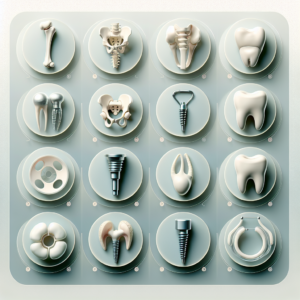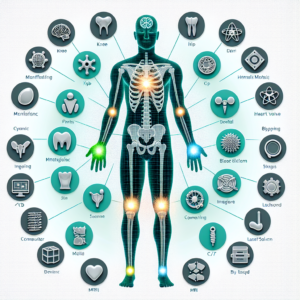Revolutionizing Healthcare: How to Create Medical Implants Using 3D Modeling

The healthcare industry has long been at the forefront of technological innovation, and one of the most transformative advancements in recent years is the use of 3D modeling and printing in the creation of medical implants. This technology is not only enhancing the precision and customization of implants but also improving patient outcomes by creating tailor-made solutions that fit each patient’s unique anatomy.
In this article, we will explore how 3D modeling is revolutionizing healthcare by enabling the creation of medical implants that are personalized, precise, and effective. From scanning a patient’s anatomy to designing the implant and 3D printing it, each step in this process presents new opportunities to improve the healthcare system.
The Role of 3D Modeling in Healthcare
What is 3D Modeling?
3D modeling involves the creation of a three-dimensional representation of a physical object, which can then be used in various applications such as simulations, printing, or analysis. In healthcare, 3D modeling allows for the accurate replication of a patient’s anatomy, leading to the development of medical implants that are tailored to fit precisely.
Over the past decade, 3D modeling has grown in importance within healthcare. Initially, this technology was used for simpler tasks like creating surgical guides, but its applications have expanded to include complex procedures such as joint replacements, cranial implants, and dental prosthetics. The main advantage of 3D modeling is that it allows for the customization of medical devices, reducing the risks associated with implants that are not well-suited to a patient’s body.
Benefits of 3D Modeling in Healthcare
- Personalization: Custom implants can be designed to fit the specific needs of individual patients, improving the success rate of surgeries.
- Precision: 3D models can capture intricate anatomical details, leading to better implant design and placement.
- Reduced Recovery Time: By creating implants that are more compatible with the patient’s body, recovery times can be minimized, leading to faster healing.
- Cost-Effectiveness: 3D modeling can reduce costs associated with traditional manufacturing methods, as it allows for efficient, on-demand production of implants.
- Innovation in Treatment: With the ability to design complex, patient-specific implants, healthcare providers can offer treatments that were previously unavailable.
Types of Medical Implants Created Using 3D Modeling
One of the most exciting aspects of 3D modeling in healthcare is the broad range of medical implants that can be created using this technology. Some of the most common types of implants produced using 3D modeling include:
Bone Implants
Bone implants are essential in surgeries that require bone replacement, such as joint replacements or reconstructive surgeries following trauma. 3D modeling allows surgeons to design implants that are custom-fit to the patient’s unique bone structure. This is particularly important in cases where the patient’s anatomy is unusual or has been altered due to disease or injury.
Examples of bone implants created using 3D modeling include:
- Hip and Knee Replacements: These implants are designed to match the exact geometry of the patient’s bones, ensuring a better fit and more natural movement post-surgery.
- Cranial Implants: In cases of traumatic brain injury, 3D modeling allows for the creation of custom implants that replace damaged portions of the skull.
Prosthetics
Prosthetics are another area where 3D modeling has made a significant impact. Traditionally, prosthetic devices were mass-produced and needed to be manually adjusted for each patient. With 3D modeling, prosthetics can be designed to fit an individual’s specific limb structure, leading to greater comfort and function.
Examples of prosthetics made using 3D modeling include:
- Artificial Limbs: 3D printing allows for the creation of prosthetic limbs that are not only better-fitting but also more affordable than traditional methods.
- Dental Implants: Custom dental implants can be designed to fit precisely within a patient’s mouth, leading to improved functionality and aesthetics.
Custom Implants for Complex Surgeries
In more complex surgeries, such as spinal procedures or facial reconstruction, 3D modeling allows surgeons to create custom implants that are specifically designed to meet the needs of the individual patient. These implants can be made to fit the unique geometry of the patient’s body, providing more effective and less invasive solutions.
Examples include:
- Spinal Implants: These implants are designed to provide support to the spine and can be customized to match the patient’s vertebral structure.
- Facial Implants: For reconstructive facial surgeries, custom implants can be created to restore both functionality and appearance.
The 3D Modeling Process for Creating Implants
The process of creating medical implants using 3D modeling is intricate and involves several key steps, each of which contributes to the final outcome. Here’s an overview of the process:
Step 1: Scanning the Patient’s Anatomy
The first step in creating a custom implant is obtaining detailed images of the patient’s anatomy. This is typically done using advanced imaging techniques such as CT scans or MRIs. These scans provide highly detailed, three-dimensional data that captures the exact structure of the patient’s bones, tissues, and organs. This data is then used as the foundation for the 3D model.
Step 2: Converting Scan Data into a 3D Model
Once the scans are obtained, the data must be converted into a digital 3D model. This is typically done using specialized Computer-Aided Design (CAD) software, which allows for the manipulation and refinement of the scanned data. The 3D model is adjusted to account for any unique characteristics of the patient’s anatomy, ensuring that the implant will fit perfectly.
Step 3: Design and Customization Using CAD
With the 3D model in place, the next step is to design the implant. Using CAD software, the design can be customized to match the patient’s needs. This may involve adjusting the size, shape, and material of the implant to ensure optimal function and fit.
In some cases, this stage may also involve simulations, where the implant’s functionality is tested in virtual environments. These simulations can help identify potential issues before the implant is produced, minimizing the risk of complications.
Step 4: Simulation and Testing
Simulation and testing are essential steps in the design process. Once the implant has been designed, it is tested to ensure that it will function as intended. This can involve running simulations to assess factors such as:
- Stress resistance to ensure that the implant can withstand the forces it will experience in the body.
- Biocompatibility to ensure that the implant will not cause adverse reactions in the patient’s body.
Step 5: 3D Printing or Manufacturing the Implant
Once the design has been finalized and tested, the implant can be created using 3D printing or traditional manufacturing methods. 3D printing is particularly well-suited for creating custom implants due to its flexibility and precision. Common materials used in 3D printing for medical implants include titanium, PEEK (polyether ether ketone), and ceramics, which are known for their biocompatibility and durability.
Technologies Enabling 3D Printing of Medical Implants
Several 3D printing technologies are commonly used in the creation of medical implants. The most popular technologies include:
FDM (Fused Deposition Modeling)
FDM is a widely used 3D printing method that involves the deposition of melted material layer by layer to create a solid object. While commonly used for prototypes, FDM can also be used to create medical implants when combined with biocompatible materials such as medical-grade thermoplastics.
SLA (Stereolithography)
SLA involves curing liquid resin with ultraviolet light to create solid layers. This method is known for its precision and is often used in creating detailed medical implants, such as dental and bone implants.
SLS (Selective Laser Sintering)
SLS uses a laser to sinter powdered material into solid parts. This method is particularly well-suited for creating metal implants, such as titanium joint replacements, as it can produce highly durable and strong components.
The Impact of 3D-Printed Implants on Patient Care
3D-printed implants have already shown significant benefits for patients. Custom implants designed using 3D modeling help address issues such as poor fit and long recovery times, which are often associated with traditional mass-produced implants. Some of the key advantages include:
- Improved fit: The ability to create implants that match the patient’s anatomy leads to better overall functionality and comfort.
- Faster recovery: Custom implants can result in quicker healing times due to better integration with the patient’s body.
- Cost savings: 3D printing can reduce the cost of manufacturing and materials, making medical implants more affordable for both patients and healthcare providers.
Regulatory Considerations and Challenges
While 3D-printed medical implants offer numerous advantages, there are also regulatory hurdles to overcome. In the United States, the FDA (Food and Drug Administration) regulates the use of medical devices, including 3D-printed implants. These devices must undergo rigorous testing and approval processes before they can be used in clinical settings. Additionally, ethical concerns about the personalization of medical implants, especially in cases involving complex procedures or vulnerable populations, must be carefully addressed.
The Future of Medical Implants and 3D Modeling
As 3D modeling and printing technologies continue to evolve, we can expect even more innovations in the field of medical implants. Advancements in materials science and bio-printing are likely to lead to the creation of even more biocompatible and functional implants. Furthermore, integration with technologies like AI and machine learning will help improve the design and manufacturing process, making it even more efficient and precise.
The development of custom medical implants using 3D modeling is a groundbreaking advancement in the healthcare field. This technology is revolutionizing patient care by allowing for the creation of personalized, high-quality implants that improve surgical outcomes and reduce recovery times. As 3D modeling and printing technologies continue to evolve, the potential for further innovation in medical treatments and healthcare will be boundless.
Visit our other website: https://synergypublish.com





